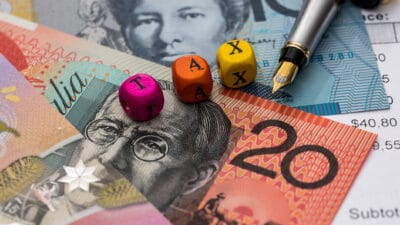So, if you've been within a bull's roar of a news website this morning, you can't have avoided a mention of two overlapping pieces of business news: the 'arrival' of a new Artificial Intelligence (AI) mob, DeepSeek, and the resultant fall in the share price of many US-listed technology businesses, most notably chip-maker Nvidia.
(The word 'DeepSeek' appears no less than 14 times on the AFR's homepage, and six times on The Australian's business page, at the time of writing!)
Taking the latter first, as many websites did, because big numbers sell, Nvidia – the company that has gained most from the explosion of AI via demand for its 'graphics processing unit' (GPU) computer chips, lost almost US$600 billion in market value overnight.
That loss was more than the entire market value of all-but 13 listed US companies. It was the largest one-day fall for any single company on record, smashing its own previous record on that front.
Why?
Well, that's where we get to DeepSeek. It's a Chinese-based AI venture, which has claimed that it can do everything the current suite of AI 'bots' can do, but with less computing power. And I mean a lot less.
As Forbes summarises it:
DeepSeek's latest product, an advanced reasoning model called R1, has been compared favo[u]rably to the best products of OpenAI and Meta while appearing to be more efficient, with lower costs to train and develop models and having possibly been made without relying on the most powerful AI accelerators that are harder to buy in China because of U.S. export controls.
And how much cheaper? Well, the company claims to have achieved that output parity while spending only US$6m on its latest model, which compares very favourably with estimates that other AI models would have cost between US$100m and US$1 billion to train and roll out.
Which, if true, is a big deal!
That sort of cost would mean many, many fewer GPUs are required – hence Nvidia's share price fall. But it also means that DeepSeek can be deployed (and presumably future models can be developed) far more cheaply, giving it an existential advantage on funding and presumably the ability to massively undercut competitors on customer pricing. That combination saw some of the biggest US tech companies also fall – just nowhere near as much as Nvidia.
Are the cost claims true? No idea. Some believe it might be creative accounting out of China to put pressure on US companies and markets. But is it? No-one knows.
Is it sustainable? Well, a day ago, many people assumed that the current suite of AI models, and the chipmaker Nvidia, were headed on a one-way trip to the moon.
How so?
Well, even after the fall overnight, Nvidia shares are still up 90% over the past year, and have increased by 20 times in value over the past five years.
And it has a price/earnings ratio of 47 times earnings.
That's a lot, for any company.
But for a company with a market capitalisation (the price of all of its shares, added together) of US$2.9 trillion dollars, that's… very ambitious.
But lest you think I'm throwing shade at Nvidia or its share price… I'm not.
But I am sitting squarely on the fence. And that's not a bad thing.
See, let's think about the multiple futures that could follow from here.
I think it's probable that AI computing power (chips and data centres) will grow to multiples of its current level. Maybe running DeepSeek. Or ChatGPT. Maybe Meta rises. Perhaps Apple. Or one of the smaller, lesser-known AI models. Or — and given how early we are in the AI journey, this might be most likely — an AI model that hasn't event been invented yet.
Maybe Nvidia supplies 95% of the chips required, at the current 90%-odd gross margins. Or maybe it has a 50% market share, and price competition pushes those margins down to 35%. Or somewhere in between, on both metrics.
Maybe the AI chips of the future aren't CPUs or GPUs, but something entirely different. Maybe invented by Nvidia. Or not.
I trust you're getting a sense of how uncertain the future is, here.
And yet, before last night, Nvidia had a P/E of over 55 times.
Remember – I'm not saying it won't go higher from here, and it could even justify that P/E and a lot more.
What I am reflecting on, though, is the investor sentiment that both pushed Nvidia to these levels in the first place, and then ran screaming the second someone shouted 'fire'.
Most specifically, I want to pose these related questions:
"If you were so sure Nvidia was worth US$3.5 trillion yesterday, why would you sell today, just because another AI model has surfaced"
And:
"If your view is that the new AI model so significantly changes the game, weren't you a little naive/arrogant/carried away to pay 55 times earnings yesterday – a level at which you needed to be pretty certain Nvidia's future was almost bulletproof?"
To be clear, I'm not criticising those who bought or sold.
But I am trying to use the example to illustrate a point.
Either the release of a new DeepSeek model should be a speed bump at best, or you had no business paying that sort of price (and a US$3.5 trillion market capitalisation) for Nvidia.
To be sure, I've regularly exhorted people with Paul Samuelson's line:
When the facts change, I change my mind. What do you do, sir?
I don't blame anyone who sees DeepSeek and questions their confidence in a previously held view. In fact, that's what they should do.
But I do want them – and us – to reflect on how much confidence we had in those views in the first place, and to what extent that's reflected in share prices.
Maybe, just maybe, we should be a little more circumspect in our predictions of the future.
Perhaps we should be a little more diversified, and a little more cautious with the prices we pay, given the known and unknown risks.
And we should probably be less jumpy when share prices move – in both directions.
Put more simply: the more certain the future, the more we should be prepared to pay. And the less certain that future, the less we should pay.
Which… is hard to remember when everyone else is making out like bandits. Envy and greed are two forces that plot together to wreck you on the investing rocks.
As Warren Buffett reminds us:
But, like Cinderella at the ball, you must heed one warning or everything will turn into pumpkins and mice: Mr. Market is there to serve you, not to guide you. It is his pocketbook, not his wisdom, that you will find useful. If he shows up some day in a particularly foolish mood, you are free to either ignore him or to take advantage of him, but it will be disastrous if you fall under his influence. Indeed, if you aren't certain that you understand and can value your business far better than Mr. Market, you don't belong in the game.
Was Nvidia worth US$3.5 trillion yesterday?
Is it worth US$2.9t today?
And whether you own Nvidia, or technology companies, or US companies, or not, that same logic applies to every company whose shares we own, or consider buying:
What is the range of possible futures? What level of confidence can I (justifiably) have in my ability to discern which of them are more and less likely? And how much should I pay, accordingly.
Note that none of those questions relies on what recent share price movements have been. They don't rely on what your mate, brother-in-law or Uber driver think. They don't rely on how many headlines are being written, or how many people are talking about it in chat rooms.
And remember: (far) more often than not, we'll end up with a simple three word summary of our view: 'I don't know'.
That's a good thing, by the way, because it saves us from being tempted to form a view just so we can say we have one.
But the average investor should have no strong view on at least 75% of the companies on the stock market… and probably many more.
And of those we have a strong view, only a small minority will be undervalued, and worth buying.
Our egos tell us to take a position. To have a view. To not miss out.
The investor's job is to restrain both ego and envy – and to only invest when we think the odds are objectively in our favour.
The bad news? That's hard to do.
But the good news? The more you do it, the easier it gets.
In the meantime, remember Aesop's fable of the tortoise and the hare.
Aesop was right.
Fool on!









